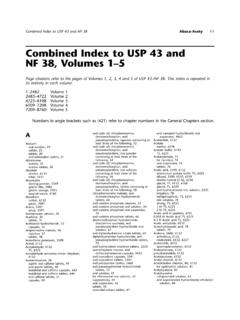Transcription of Ketotifen – Novel Uses for a Mast Cell Stabilizer
1 12/9/2020 Constant Phone 601-707-7545 Fax ABOUT USCOMPOUNDINGSTERILE COMPOUNDINGHOW TO WRITE FOR ACOMPOUNDED RXPRESCRIBER FORUMT hank you for entrusting in the compounding services at MadisonMedical Compounding Pharmacy to help meet the uniquemedication needs of your patients. We are excited to share ourmonthly newsletter with you and look forward to working with don't hesitate to let us know how we can assist you and Chambers, and Matthew Chambers, Novel Uses for a Mast Cell Stabilizer Ketotifen is an oral antiallergic drugdeveloped in 1970 by SandozPharmaceuticals and initially marketed as aninhibitor of anaphylaxis.
2 As a relativelyselective, non competitive H1 antagonist andmast cell Stabilizer , Ketotifen is used fortreating a variety of conditions includingasthma, atopic dermatitis, food allergies,allergic rhinitis, mast cell activation syndrome(MCAS), and more. In multiple studies, oralketotifen has been shown to be superior toother antihistamines for treating MCAS, andrecently has been prescribed for MCAS related to chronic inflammatory response syndrome(CIRS). Most studies published on the use of Ketotifen have focused on its benefits in childhood andadult asthma.
3 However, by inhibiting the release of proinflammatory mediators, Ketotifen canprevent the vascular permeability changes that are involved in the development of wheal andflare responses. Thus, it can be used in the management of urticaria (hives). Several studieshave been published evaluating the use of Ketotifen for the management of urticarialsyndromes, including cold-induced urticaria, heat-induced urticaria, exercise-inducedurticaria, pressure-induced urticaria, cholinergic urticaria, and chronic idiopathic urticaria. A review of shows evaluations of Ketotifen by oral administration forfibromyalgia, atopic dermatitis, attenuation of reactions during peanut desensitization, allergicrhinitis, asthma, and post-traumatic joint contractures.
4 For adults and older children withasthma or allergic disease, the recommended dose of Ketotifen is 1 mg twice daily. For youngchildren 6 months to 3 years old, the recommended dose is mg twice daily. Oral Ketotifen is usually well tolerated, with the most frequent side effect being sedation inapproximately 10% to 20% of patients, especially at higher doses, but sedation typicallydecreases within 1 to 2 weeks of use. Less common adverse reactions include dizziness, dry12/9/2020 Constant , nausea, and headache, which have been reported in 1% to 2% of patients at initiationof therapy.
5 However, these side effects do not persist in patients on long-term gain and central nervous stimulation also have been reported in a small number ofpatients. Ketotifen may potentiate the effects of central nervous system depressants,antihistamines, and alcohol. Concomitant use of oral Ketotifen with oral diabetic agents, suchas glyburide and metformin, may result in reversible thrombocytopenia. The oral tablet form of Ketotifen is commercially available in Canada, Europe, and Mexico,but oral, nasal, and topical Ketotifen is only available in the United States by prescriptionthrough compounding pharmacies, An over-the-counter ophthalmic solution is approved inthe United States to treat allergic Mast Cells to Relieve Post-COVIDS yndrome?
6 Regardless of the severity of SARS-CoV-2 disease (COVID-19), a high proportion of patientsstruggle with persistent respiratory or systemic symptoms after recovery. "Post-COVID syndrome" includes dyspnea, chest pain, generalized fatigue and joint pain, and pulmonaryfibrosis is one of the causes. Besides T-lymphocytes and macrophages, mast cells alsocontribute to the development of cytokine storm and thus stimulate the activity of fibroblastswhich directly facilitate the progression of pulmonary fibrosis. Due to its ability to stabilizemast cells, Ketotifen may be useful in the treatment of post-COVID-19 pulmonary fibrosis andin relieving the symptoms of post-COVID Mast Cells with Ketotifen : A Potential Strategyfor Multiple Sclerosis Therapy?
7 Multiple sclerosis (MS) is a chronic autoimmune disease of the central nervous system(CNS) characterized by extensive inflammation, demyelination, axonal loss and indicates that mast cells contribute to immunopathogenesis of both MS andexperimental autoimmune encephalomyelitis (EAE), which is the most employed animalmodel to study this disease. Considering the inflammatory potential of mast cells, theirpresence at the CNS and their stabilization by certain drugs, the effect of Ketotifen fumarateon EAE development was studied in mice.
8 Early intervention with Ketotifen significantlyreduced disease prevalence and severity. The protective effect was concomitant with lessNLRP3 inflammasome activation, rebalanced oxidative stress, and reduced T cell infiltrationat the CNS. Ketotifen administration decreased the local expression of enzymes that aretypically produced by mast cells. Evaluation of the CNS-barrier permeability indicated thatketotifen clearly restored the permeability levels of this barrier. Based on the concept thatmast cells are particularly relevant in MS immunopathogenesis, Ketotifen as a knownstabilizer of mast cell activity has the potential to be used in MS : Treating Irritable Bowel Syndrome withDiarrhea A study investigated the use of Ketotifen for the treatment of irritable bowel syndrome withdiarrhea (IBS-D).
9 A total of 108 IBS-D patients were randomly divided into a Ketotifen group(n = 55) and a control (placebo) group (n = 53). The patients in the Ketotifen group received Ketotifen 1 mg oral tablets two times daily;patients in the control group received oral placebo. Before and after 8 weeks of treatment,gastrointestinal symptoms, anorectal sensory function and the number and activity status ofmast cells were assessed for both groups. The overall effective rate of gastrointestinalsymptom improvement in the Ketotifen group was significantly higher than that in the controlgroup ( vs.)
10 First sensation, defecation urgency and discomfort/pain threshold inthe Ketotifen group improved significantly after treatment; no significant changes wereobserved in the control group. Six patients ( ) in the Ketotifen group experienceddrowsiness and fatigue, but the symptoms disappeared after 1 week of Ketotifen significantly alleviated gastrointestinal symptoms and improved visceralhypersensitivity in patients with IBS-D. The therapeutic effect of Ketotifen is related to areduced number and decreased activity of mast cells in the intestinal mucosa, especially inthe terminal and Budesonide Nasal Spray for Treatmentof Allergic Rhinitis A total of 96 allergic rhinitis patients were treated with Ketotifen fumarate and budesonideadministered as a combination nasal spray.



